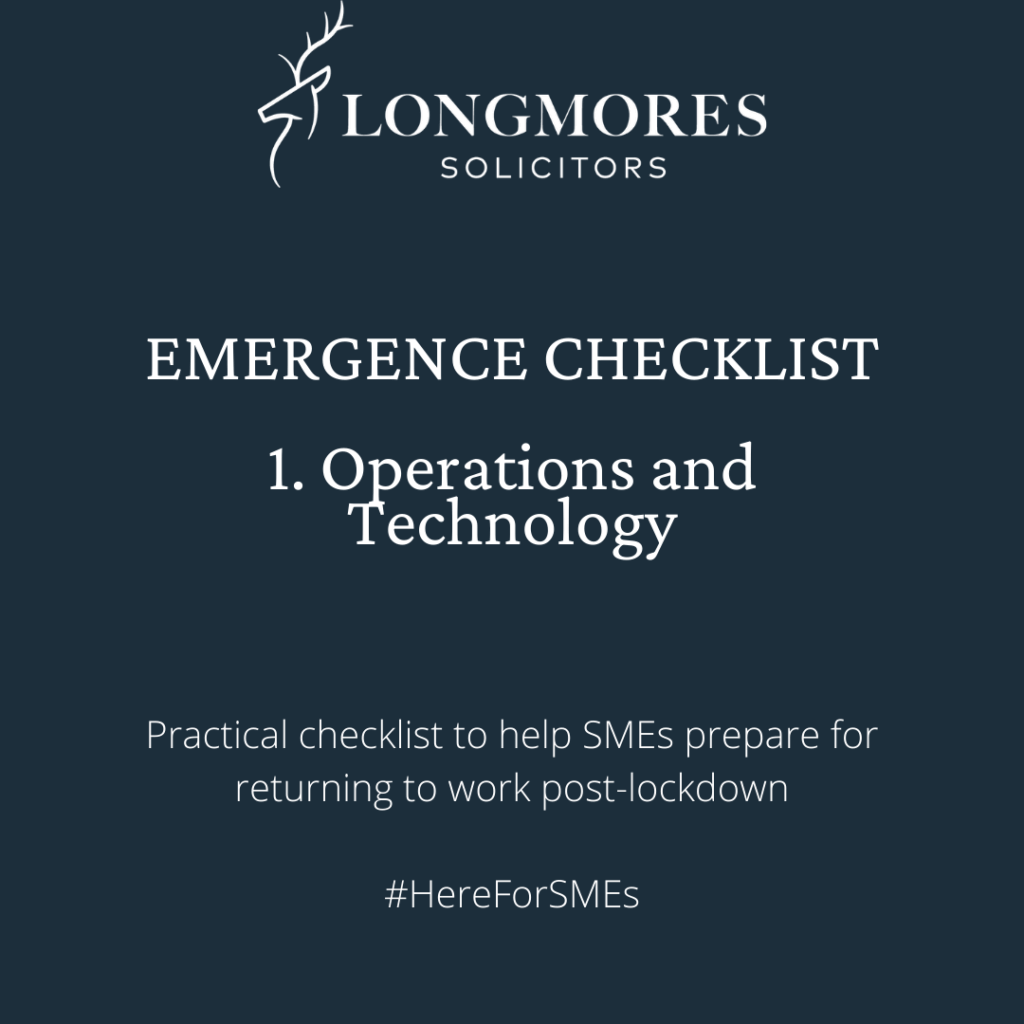Emergence Checklist – 1. Operations and Technology
We are still in lockdown but are about to move to the emergence stage, when lockdown restrictions are relaxed, and we slowly emerge back into offices and ordinary lives.
We have set out below a useful emergence checklist to help you prepare your business for the ‘post lockdown’ era. In the first of this series of four blogs, we focus on your business operations and technology.
As we move towards the “new normal”, it is likely that the way your business has operated in the past will need to be adjusted, if only for the next few months. This will impact on your business model and will require you to think ahead, in order to hit the ground running when the lockdown ends.
The areas to focus on fall into three different areas:
- Technology
- Staff and customer-facing spaces
- Operations, including processes and logistics.
10-point Checklist
1. What does your technology capability look like?
Will people still be able to utilise remote working? For employees in the office consider how they will be able to interact with those based at home. Will video conferencing still be applicable once the office is up and running again? Do you need to reconsider the positioning of telephones and multi-user equipment (such as photocopiers)? Consider a phased switch on to avoid overloading the system.
2. Social distancing will be important.
What measures can you realistically implement to ensure that your business can comply with the social distancing rules? Do you need to review your staffing requirements to be able to meet them? Are shift patterns or working patterns going to need to be adapted to reflect social distancing?
3. How will your customer experience be affected?
Will you need to adjust how appointments are made to ensure that the relevant measures to reduce contact points can be implemented? Do you need to have hand sanitiser in place for customers who visit? Have you increased signage to provide guidance around what visitors should be doing?
4. What does the return to work look like for furloughed employees?
Will you be looking at a phased return to work for those employees who have been furloughed? Do you need to consider shift patterns and whether they should be adjusted? Will the working day be different? If so, consider communications to inform staff what new procedures and protocols may be required, for example use of hot desking and cleaning. Consider who is returning and when, as thought will need to be given to those who are in the shielding group, any public transport constraints and childcare.
5. Will your operations resume at the previous rate?
Do your processes need to be adjusted to reflect a reduced turnover? Do you need to make changes to ensure that social distancing can be enforced on the shop floor?
6. Are your Health & Safety procedures up to date?
An event such as this pandemic triggers a need to review your risk assessments and record the significant findings of the review. Follow all your normal safety practices, incorporating existing and any new regulatory policies, procedures and control measures, for example using guidance published by the HSE.
Consider whether and how social distancing can be maintained in the workplace. Determine whether you have sufficient appropriate collective and personal protective equipment, if required.
Consider hygiene issues, such as a deep clean of premises, how shared equipment will be sanitised and facilities for washing of hands, as well as stocks of cleaning agents. Train staff, including cleaners, on new or revised safe systems of work.
Consider the use of PPE outside the workplace e.g. on public transport.
7. Can work in progress be completed?
Do you have the necessary stock in hand to complete outstanding work in progress? Have you communicated with your customers with outstanding orders to determine when/if they need the orders completing? Are your suppliers able to provide you with the goods you need to complete your orders? Identify any potential issues with throughput to ensure that you can complete in good time.
8. Review your supply chain
Speak with your suppliers to understand what challenges they are facing. Identify any weaknesses in the ability to supply and research alternatives, especially if there is a heavy reliance on imported goods. Do you need to source certain products from elsewhere?
9. Book your haulage in advance
Many businesses will be opening up at similar times. Make sure that you confirm your haulage and other logistics requirements in advance so that you can minimise any delays to customers. Consider whether you need to adjust how deliveries are made to maintain social distancing and whether drivers need to be provided with PPE.
10. Consider what your customer service offering looks like
Do you need to use technology in a different way to meet the needs of the remote end user? Can you fulfil any requirements for repairs or returns safely? Think about whether you can make any changes that may enhance your offering to customers/clients.
A final point – Insurance
Insurance is a vital part of your business continuity planning, risk management and protection. You may need to consider three key insurance areas:
- Review lockdown and avoid any exposed risks
- Prepare for renewals early, as renewals are likely to take longer
- Review your business risk assessment and consider whether your current insurance cover is appropriate, particularly in relation to cyber-security, management liability and professional indemnity.
Contact the Company Commercial team on 01992 300333 or email enquiries@longmores.law should you need any help with your business.
Request a full copy of the report including all four checklists.
Please note the contents of this blog are given for information only and must not be relied upon. Legal advice should always be sought in relation to specific circumstances.

